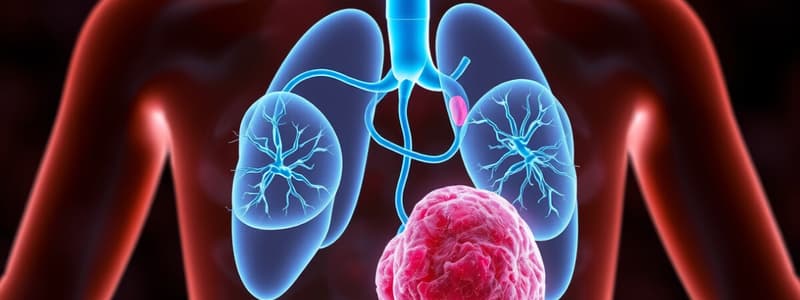Podcast
Questions and Answers
What is the standard free-energy change for the complete oxidation of glucose?
What is the standard free-energy change for the complete oxidation of glucose?
−2,840 kJ/mol
What is glucose primarily used for in the body?
What is glucose primarily used for in the body?
- Structural role
- Metabolic energy (correct)
- Energy storage (correct)
- Transportation
Glycolysis is the only metabolic pathway that degrades glucose.
Glycolysis is the only metabolic pathway that degrades glucose.
False (B)
How many steps are involved in glycolysis?
How many steps are involved in glycolysis?
What are the two molecules produced from one molecule of glucose during glycolysis?
What are the two molecules produced from one molecule of glucose during glycolysis?
What is the first committed step in the glycolytic pathway?
What is the first committed step in the glycolytic pathway?
The phosphorylation of glucose is necessary for it to leave the cell.
The phosphorylation of glucose is necessary for it to leave the cell.
Glyceraldehyde 3-phosphate is converted to ___ during glycolysis.
Glyceraldehyde 3-phosphate is converted to ___ during glycolysis.
Match the following compounds with their roles in glycolysis:
Match the following compounds with their roles in glycolysis:
Flashcards are hidden until you start studying
Study Notes
Overview of Glycolysis
- Glucose serves as a central metabolite, rich in potential energy, with a standard free-energy change of -2,840 kJ/mol upon complete oxidation.
- Can be stored as polymers like starch or glycogen, maintaining low cytosolic osmolarity.
- Acts as a versatile precursor for various biosynthetic reactions.
Glycolysis Pathway
- First metabolic pathway elucidated; derives from Greek words meaning "sweet" and "splitting."
- An essential pathway for glucose catabolism with the largest carbon flux in cells.
- Breaks down one glucose molecule into two pyruvate molecules through a series of enzyme-catalyzed reactions.
- Key energy source in certain mammalian tissues (e.g., erythrocytes, renal medulla, brain, sperm).
- Produces energy carriers ATP and NADH during the process.
Steps of Glycolysis
- Comprises 10 steps, with the first 5 forming the preparatory phase.
- In the preparatory phase, ATP is invested to increase the free-energy content of intermediates, leaving glyceraldehyde 3-phosphate as a common product.
Phosphorylation and Retention
- Phosphorylated sugars typically cannot exit the cell due to lack of transporters on plasma membrane.
- Initial phosphorylation allows retention of intermediates without further energy input, despite significant concentration differences.
- Energy from phosphoanhydride bond breakage (e.g., ATP) is conserved in the formation of phosphate esters like glucose 6-phosphate.
Key Reactions
- Conversion of Glucose 6-Phosphate to Fructose 6-Phosphate: Occurs before the committed step of glycolysis.
- Phosphorylation of Fructose 6-Phosphate: The PFK-1 reaction is largely irreversible and commits fructose 6-phosphate to the glycolytic pathway.
- Cleavage of Fructose 1,6-Bisphosphate: Involves reversible aldol condensation; despite a positive standard free-energy change, the reaction is reversible due to reactants' low concentrations in cells.
Interconversion of Triose Phosphates
- Two triose phosphates produced (glyceraldehyde 3-phosphate and dihydroxyacetone phosphate); only glyceraldehyde 3-phosphate is directly degraded in glycolysis.
- Dihydroxyacetone phosphate quickly converts to glyceraldehyde 3-phosphate.
Energy Gain in Glycolysis
- Energy payoff occurs in later steps where glyceraldehyde 3-phosphate is oxidized and phosphorylated to form 1,3-bisphosphoglycerate.
- Two molecules of pyruvate are formed while conserving energy via the phosphorylation of ADP to ATP, resulting in a net yield of two ATP per glucose.
- Additionally, two NADH electron carriers are produced.
Oxidation of Glyceraldehyde 3-Phosphate
- First key energy-conserving reaction leading to ATP formation.
- The oxidation of the aldehyde group of glyceraldehyde 3-phosphate results in a carboxylic acid anhydride with phosphoric acid.
Studying That Suits You
Use AI to generate personalized quizzes and flashcards to suit your learning preferences.




